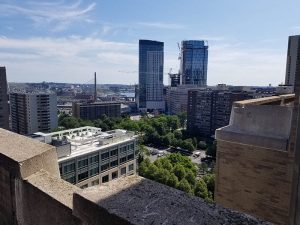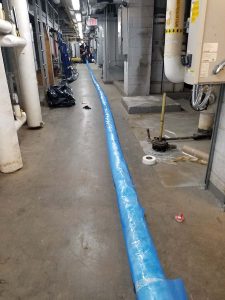Boston Sewer Repair Company Lines a 180-foot Vertical Pipe with a Steam Cured Liner!

What do you do when you have a vertical pipe that needs lining and it extends 15 floors straight up? You get bright fast…

When a Massachusetts hospital discovered that the drain pipe running between the exterior and interior walls from the 15th floor of their structure was leaking, they called New England Pipe Restoration, Inc., a recent addition to Formadrain’s licensee network.
Rather than apply a brush coating to the pipe, which would have taken the better part of a week to complete, New England Pipe Restoration decided to use a Formadrain steam-cured CIPP liner.
Access to the drain pipe at the downstream end was in a stairwell where a section of concrete wall had been removed to allow access to a dandy, a type of in-line cleanout. New England Pipe Restoration wetted out the liner on-site using Formapox 101.
Because the 180-foot drain pipe extended 15 floors up, the job presented some special challenges, the first of which was how to furnish the steam needed to cure the liner. Positioning a boiler on the hospital roof would have proven to be what Scott Tessier, owner of New England Pipe Restoration, describes as a “permitting nightmare”. Luckily, the hospital was very cooperative in allowing the use of their steam generation equipment located in the hospital’s mechanical room.

The next challenge was how to smoothly insert the heavy 90-foot liner sections. Each of the two sections consisted of 90 feet of fiberglass, resin, and mandrel and weighed in at well over 200 pounds. To ensure vertical insertion of the liner, New England Pipe Restoration designed system that allowed the liner to roll over a drum and straight down into the pipe, eliminating any harsh turns. The liner sections were unwound from the Formadrain reel bolted to the floor.
Then there was the issue of how to supply air. There was no available parking space in which to park a truck and run hoses to the roof. Not wanting to place a diesel or gas-powered compressor on the hospital roof, New England Pipe Restoration wired and supplied an electrically-powered compressor.
Lining a vertical pipe presents its own special challenges in that, unlike laterals, there is no solid surface of ground supporting the host pipe. Installers must also be mindful of the effects of gravity. While the usual procedure for lining laterals is to end-plate the mandrel, that cannot be done in a vertical application such as this because the high heat creates the potential to make the resin less viscous and “slide” down the fiberglass. After placing the two sections of liner, they applied cold air first and then introduced steam.
The entire job, not including prepping the pipe, took only two days from start to finish.
In keeping with Formadrain’s outstanding licensee support practices and their conviction that “the licensee’s success is our success”, Carl Marc-Aurele, Vice President of Formadrain and one of Formadrain’s leading trainers, was on site to lend a hand and bring the benefit of his vast experience. This job was New England Pipe Restoration’s second installation of a Formadrain liner and Scott said “I wasn’t going to do that one without him!” He laughingly adds “It was a fun challenge. It was fun because it came out well.”
To find out how you can expand your product offering by becoming a Formadrain licensee, call Bruce Stevenson, Business Development Manager, at 1-888-450-3986 or email Bruce@formadrain.com.
